Unbroken Stride: Cameron’s Story of Hope, Overcoming Brain Injury to Cross the Finish Line
Published on: June 10, 2024
In many cultures, the gingko tree symbolizes hope and resilience. After Cameron Kuklick experienced a severe traumatic brain injury (TBI) at the age of 30, a gingko tree in a hospital courtyard became a symbol of hope and healing for him and for his family. Cameron and his family hope that by sharing their story and experiences, they too can provide hope and healing for others.
The Journey Through Brain Injury Begins: The Accident
On September 24, 2022, Cameron fell from a motorized rental scooter while returning to his hotel after celebrating his brother’s wedding in Harrisonburg, Virginia. Although Cameron doesn’t recall the accident, his parents Susan and Eric Kuklick received the call that every parent fears. Cameron, a previously healthy 30-year-old heavy equipment trainer, known for his love of running and adventure, was unconscious and had been airlifted to the University of Virginia Medical Center in nearby Charlottesville. No one at that time knew he would spend the next month in the Nerancy Neuroscience Intensive Care Unit (NNICU).
After Cameron arrived at UVA, a computed tomography (CT) scan of his brain showed contusions (or bruising) and swelling in multiple areas, along with fractures at the base of his skull. Other imaging demonstrated bruising to his lungs. The teams taking care of him decided to place an intracranial pressure (ICP) monitor, which revealed elevated pressure inside his skull. When traumatic brain injuries cause elevated pressures there is risk for additional brain injury, and action had to be taken quickly to prevent further damage. A team of physicians, advanced practice providers, nurses, and respiratory therapists began working to control the pressure with measures including using sedation to induce a coma, as well as medically treating the brain swelling. Cameron’s brain wasn’t the only area that had been seriously injured, though, as he required the help of a ventilator because of the injury to his lungs, and the team also diagnosed him with pneumonia, which required treatment with antibiotics.
|
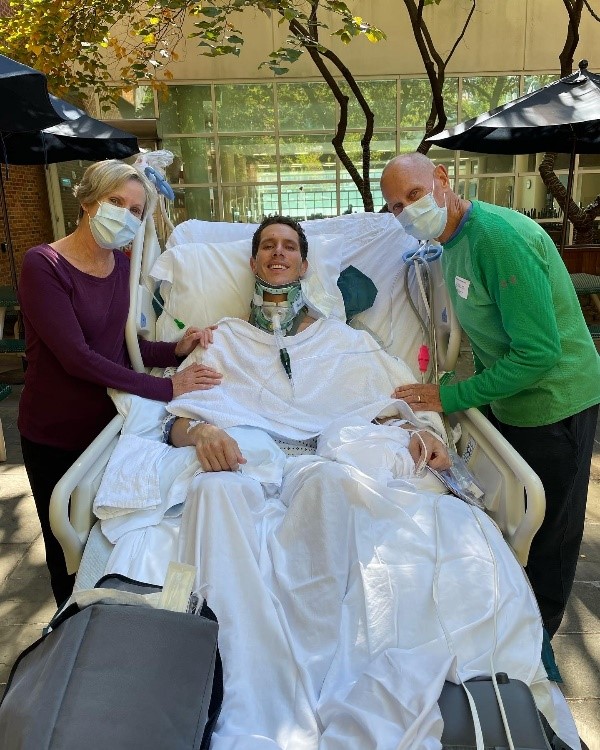 Cameron enjoying some fresh air outdoors with his parents Cameron enjoying some fresh air outdoors with his parents
|
Family as Part of the Team: Getting to Know Cameron
During daily rounds in the neurocritical care unit, the goal is to be as collaborative as possible, and this is accomplished by interprofessional rounding. Rounds are a time for everyone providing care to share information and develop a management plan. In the UVA NNICU, families are invited to participate, listen to the team, ask questions, and contribute information. In Cameron’s case, rounds also became an opportunity for the entire team to learn more about Cameron before his injury through his mom, Susan, and dad, Eric.
Bhiken Naik, MBBCh, is the Associate Medical Director of the NNICU and was part of Cameron’s neurocritical care team. “To me, the most memorable part of Cameron’s care – besides his medical complexity – were the daily anecdotes about his life and the pictures that his mother shared with the team,” Dr. Naik remembers. “We got to see the vibrant life he enjoyed before his injury, and one that we hoped to give back to him.”
Each day after the treatment plan was developed and questions were answered, Susan showed the team a picture of Cameron often doing something adventurous like running an ultramarathon in New Zealand, working high up in the trees as an arborist in Virginia, or climbing Mt. Hood in Oregon, but also sometimes just spending time with his family. These pictures became an anchoring point for the family and the care team, and rounds became a time for hope – hope that the care team and family working together could not only save Cameron’s life, but also minimize the long-term impact of his TBI.
A Bump in the Road
About 10 days after Cameron’s accident, things seemed to be getting better. The ICP monitor was removed and he was starting to show signs of waking up as the sedating medications were weaned. Although still suffering from the bruising to his lungs from the initial accident and subsequent pneumonia, everyone was hopeful that Cameron would soon be free of the breathing machine. However, Cameron’s oxygen levels suddenly declined, requiring more support from the ventilator. A CT scan of his chest was performed and revealed a serious complication. A large blood clot had formed in the inferior vena cava (the vein that returns blood from the lower body to the heart) and was moving around dangerously close to the heart. Some parts of the clot had already blocked blood flow from the heart to areas of the lungs. Dr. Naik and the team were very concerned that even more of the clot would break free, block off even more blood flow to Cameron’s lungs, and possibly lead to weakening of his heart.
|
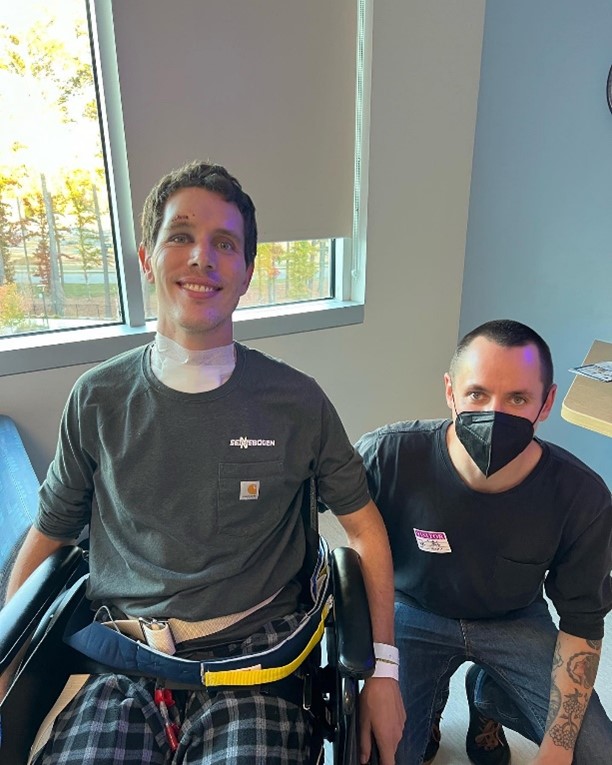 Cameron (with his brother Cory) while in rehab Cameron (with his brother Cory) while in rehab
|
Blood thinning medications were started, and after extensive discussion with vascular specialists and Cameron’s parents, a decision was made to attempt to remove the clot. This would be accomplished by inserting a catheter into the vein, which would then use a suction device to remove the clot. Although not without risk (as additional clot could be dislodged), the procedure provided Cameron the best chance of recovering with good lung function, something that was important to Cameron’s previously active lifestyle. Luckily, the clot was able to be successfully removed, and Cameron once again began to improve.
Continued Recovery
A few weeks into Cameron’s hospital stay, a tracheostomy and feeding tube were placed to help support him while he recovered. As the sedation and ventilator were weaned, Cameron began to show signs of physical and cognitive improvement. His father Eric recalls the memory that he says stands out most as a moment of hope. “Cameron turned 31 while in his coma in the ICU. Once he started waking up, the nurses would always ask him basic questions to gauge his level of responsiveness and awareness. At first he never responded, until one day he did! He was asked ‘Cameron, how old are you?’ Cameron raised his hand and signed that he was 30 years old. I was so in shock that he finally answered a question that I thought I was hallucinating. But it got even better. After about five seconds, he changed his answer to 31! I sat stunned, not believing what I just saw. At that moment, I had hope. I thought, ‘he’s going to be okay’.”
Meanwhile, Cameron’s mom Susan adds, “When Cam was first coming out of his coma, during a PT session where Cam was aided in standing up for the first time, the therapist asked him if he’d like to hug his parents. He nodded yes. She helped him keep his balance and he embraced Eric and I. Hands down the best hug ever!”
|
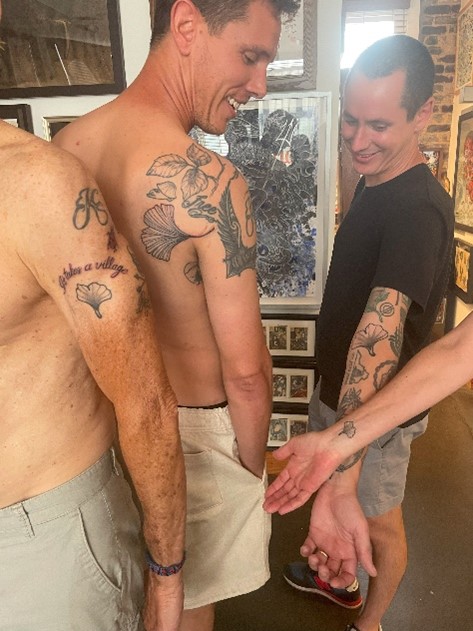 Cameron and his family show off the gingko leaf tattoos they got as symbols of hope and healing Cameron and his family show off the gingko leaf tattoos they got as symbols of hope and healing
|
About four weeks after his accident, Cameron was ready to transfer from the ICU to the step-down unit, but not before his detour to see the hospital’s gingkos. His nurse, anticipating that time outside would be healing for her 31-year-old patient with a love of nature, suggested taking a detour through the hospital’s courtyard, which was lined with gingkos turning their brilliant autumn yellow.
Cameron’s mom Susan recalls the moment: “It was a beautiful day and Cam seemed to soak up the sun and looked at all the gingko trees. I remember feeling incredibly hopeful and grateful in that moment.” Then days later, toward the end of October, Cameron transferred to Sheltering Arms Institute for Rehabilitation. While there he progressed quickly from inpatient to outpatient rehab, finally arriving back home to his parents’ house in Ashburn, Virginia on November 5. By the start of the new year, he was starting to ease back into his role as a traveling heavy equipment trainer.
It Takes a Village
In addition to the medical care that he received (and his underlying level of physical fitness), Cameron and his family credit much of his recovery to a wide support network. Cameron notes that when he first started to wake up, his family told him about the outpouring of love and support they received from their family, friends, coworkers, and neighbors. “Still confused and half-drugged, I responded, ‘It takes a village.’ That became something of a refrain for us throughout my recovery.” The Kuklicks are quick to admit that their village did not stop its support even once Cameron left the hospital and was back home and at work.
On April 1, only five months after leaving Sheltering Arms, Cameron’s family was at the finish line to help celebrate his completion of the Charlottesville marathon. But they were not the only ones who rejoiced in this accomplishment. News quickly spread among their village and beyond, especially once Cameron and his family triumphantly walked from the finish line to the ICU. As the gingko trees in the nearby courtyard were beginning to sprout their leaves, Cameron was able to reunite with the ICU staff that had helped care for him and show them just how far he’d come, and how their hard work had paid off in the end.
|
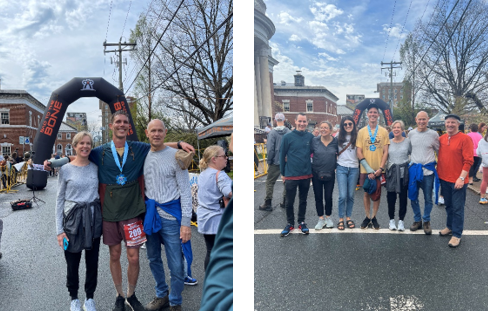
Cameron celebrating at the Charlottesville marathon finish line with family and friends
|
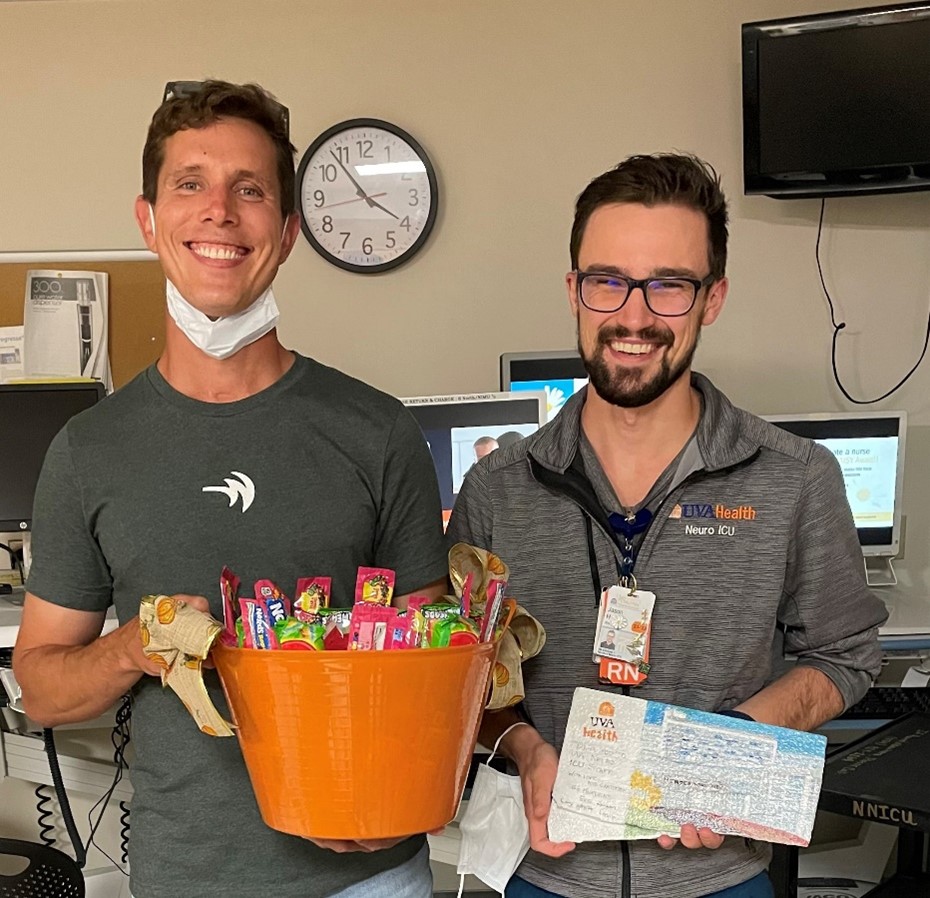
Cameron with Neuro ICU nurse Jason Hall, who cared for Cameron during some of his most challenging days
|